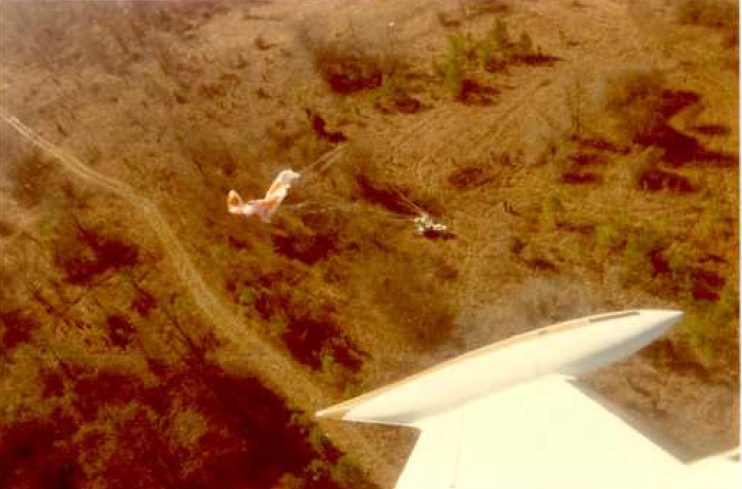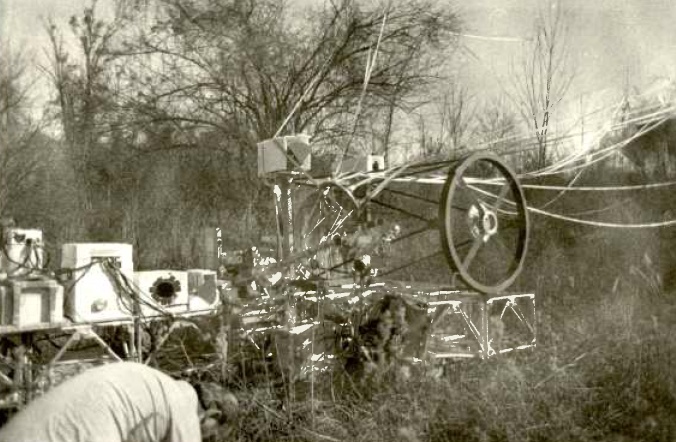Purpose of the flight and payload description
The Imperial College 41-inch telescope was a Cassegrain instrument designed for far-infrared astronomical observations. The instrument was developed during the 1970's decade by the Astronomy Group at the Blackett Laboratory, Imperial College London.
At left we can see a description of the instrument (click to enlarge). The primary mirror had a diameter of 41 inches with a spherical shape and a focal ratio of f/2.9, while the secondary mirror, also spherical, measured 13.6 inches in diameter. A flat tertiary mirror redirected the light beam at a 90° angle towards the detectors. All mirrors were crafted from aluminum alloy, gold-coated for optimal reflectivity, and tested to ensure a surface accuracy better than 4 micrometers. The primary mirror underwent traditional polishing techniques after a hard nickel layer was deposited.
The telescope was constructed entirely from aluminum alloy to ensure a negligible thermal focal shift, a crucial feature given the temperature variations during balloon flights. This design choice eliminated the need for an active focusing mechanism, simplifying operations and reducing weight. The structure incorporated Serrurier trusses, with shock-mounted supports for the 105-kg primary mirror to prevent displacement under varying attitudes. The entire system weighed 215 kg, including optics, and was kinematically mounted for stability during flight.
The system's design minimized thermal emission interference, with the secondary mirror acting as the entrance pupil and ensuring that the detector field did not extend beyond the primary mirror's edges. The aluminum optics were highly resistant to impact damage and thermal gradients, further enhancing durability and performance.
The telescope employed two helium-cooled composite bolometers for detection, allowing simultaneous two-color photometry in the 40-80 micrometer and 80-400 micrometer ranges. Each bolometer operated at a cryogenic temperature of 1.7 K, with a cold stop precisely aligned at the focal plane to restrict the field of view to 3 arcminutes. Helium-cooled filters provided wavelength selectivity, incorporating materials such as KRS-5 and diamond-dusted layers for effective spectral filtering. The detectors and filters were housed within a liquid-helium-cooled copper shield to reduce thermal noise.
A resonant focal plane chopper system facilitated rapid switching between source and background observations, minimizing microphonic noise and ensuring stability. The system used paired mirror carriages on parallel springs, driven electromagnetically with internal momentum conservation. Onboard electronics processed signals via phase-sensitive detectors with telecommandable parameters, complemented by a system for offset signal cancellation.
A key component of the system was the stabilized balloon platform (SBP) on which the telescope was mounted. It was designed and constructed by GEC Marconi Electronics Ltd. for the U.K. Science Research Council (SRC) and operated by a team from SRC's Appleton Laboratory. The gondola with dimensions of 10 feet by 15 feet by 9 feet high was stabilized in three axes-azimuth, elevation, and roll-using a central gimbal-torque-motor cluster suspended from the balloon, with the balloon itself served as the reaction mass for azimuthal stabilization.
It featured two guidance modes. In the degree mode, azimuthal position information came from magnetometers, while accelerometers were used for roll and elevation. In the arcminute mode, a star sensor provided position information, capable of detecting stars up to a magnitude limit of +5. Rate information in both modes was sourced from a three-axis gyro package. The star sensor could offset ±5° in both elevation and cross-elevation to aid telescope acquisition and tracking of fields without suitable guide stars. Additionally, a TV camera provided a 10° star field view to assist in locating guide stars.
An auto-balancing system pumped fluid between tanks at the roll and elevation axis ends, redistributing weight whenever torque demand exceeded 2 Nt-m. For launch and parachute descent, the gondola was stowed by pumping extra fluid into specific tanks, parking the platform at -5° in elevation and +5° in roll.
Power came from sealed nickel-cadmium batteries, while telemetry and telecommand relied on systems provided by the National Scientific Balloon Facility which was in charge of the flights. The total payload weight below the parachute was approximately 2800 pounds.
Details of the balloon flight
Balloon launched on: 12/16/1976 at 17:35 CST
Launch site: Columbia Scientific Balloon Facility, Palestine, Texas, US
Balloon launched by: National Scientific Balloon Facility (NSBF)
Balloon manufacturer/size/composition: Zero Pressure Balloon Winzen - 122.334 m3 (25.40 microns)
Flight identification number: 1003P
End of flight (L for landing time, W for last contact, otherwise termination time): 12/17/1976 at 1:31 CST (L)
Balloon flight duration (F: time at float only, otherwise total flight time in d:days / h:hours or m:minutes - ): 8 h
Landing site: Near Uniontown, Alabama, US
Payload weight: 1408 kgs
The mission was launched as Flight 1003-P at 17:35 CST on December 16, 1976 from the National Scientific Balloon Facility (NSBF), in Palestine, Texas, after some ten days had been spent on the refurbishment of the SBP (damaged on the previous flight) only four of which were needed to prepare the IC payload, and three or four further days of waiting for suitable weather conditions. The geographical track of this flight is shown in the figure above. The float altitude of 104,000 ft (31.7 km) was reached at 19:25 CST and the balloon passed out of telemetry range at 23:34 CST, giving the experimenters only 4.2 hours of usable time at float. This was shorter than for flight 998-P because of an increase in the stratospheric wind speed.
Having followed a more southerly path, flight 1003-P was over sparsely populated ground after the loss of telemetry and was therefore valved down without delay. The payload was cut down from about 70,000 ft at 00:45 CST and impact occurred at 1:31 CST about 30 km southwest of Uniontown, Alabama after a total flight lenght of 930 km. The descent, of course, could not be followed visually by the aircrew, but the impact scene was located and photographed from the air on the following morning and reached by the ground crew about eleven hours after impact.
The impact occurred 20 miles southeast of Uniontown, Alabama some forty-four minutes after cutdown in terrain which consisted of flat, dry heath covered in thick brambles and a few small scattered trees. The payload landed in a horizontal position on its crush pads, which failed to collapse; but it was apparent to the recovery crew that it had swung on its parachute in such a way that the space frame under the front right corner of the telescope struck the ground first and suffered a substantial horizontal force. This was later confirmed by the distortion of one
of the radial supports of the primary mirror in the same direction. There was no other impact damage to the payload at all, with the minor exception of a bend in a Serrurier truss where an item of equipment up the suspension train (probably the balloon control receiver) fell on top of it.
The open terrain made the recovery of the payload within the six hours remaining before sunset straighforward. The only outside assistance that was required was the loan of a homesteader's four-wheel drive pickup truck to haul our laden trailer through a shallow, wide ford to the nearest firm track. The valuable helium control valve receiver free falls with the deflated balloon after cutdown and was recovered during the night from a pecan orchard outside Lauderdale, Mississippi. All the equipment was returned safely to the NSBF two days later.
External references
- Far infrared astronomy Sci. Prog., Oxf. (1979) 66, 119-150
- Far-infrared astronomy with a balloon telescope Thesis by Sugden, Keith Charles, Imeprial College, 1978
- National Scientific Balloon Facility Annual Report, FY 1977 National Center for Atmospheric Research, 1978
- The Imperial College 41-inch telescope for far-infrared balloon astronomy Optical Engineering, vol. 16, Nov.-Dec. 1977, p. 558
10220If you consider this website interesting or useful, you can help me to keep it up and running with a small donation to cover the operational costs. Just the equivalent of the price of a cup of coffee helps a lot.





